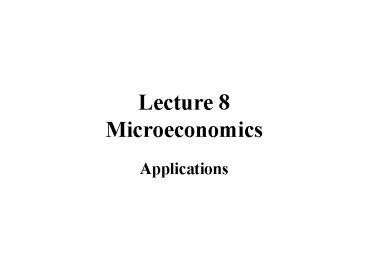Lecture 8 Microeconomics - PowerPoint PPT Presentation
1 / 26
Title:
Lecture 8 Microeconomics
Description:
The endowment effect: when the wage rate increases, the value of the worker's ... Endowment effect. A. B. C. D. Decomposing the. effect of a change in w. Education ... – PowerPoint PPT presentation
Number of Views:60
Avg rating:3.0/5.0
Title: Lecture 8 Microeconomics
1
Lecture 8Microeconomics
- Applications
2
Outline
- Application 1 Labor supply
- Application 2 Education
3
Labour supply
- competitive labour market
- individual workers who supply hours of labour to
the market. - Trade-off between leisure and consumption.
- The workers like consumption but
- dislike work (because they have to forego leisure
when working).
4
Objectives of choice
where
C consumption
L leisure
5
Indifference curves
MRSL,C
u
C
B
A
C
L
6
The budget constraint
The worker faces two constraints
The time constraint Lmax LS
The budget constraint pC wS M
Lmax total number of hours S hours of
work w wage rate M non-labour
income p price of consumption
7
Combine the two.
Total expenditure
Total endowment
S
full income
Real wage
8
The budget line
C
(MwLmax)/p
Slope -w/p
M
L
Lmax
S
9
The Choice
MRSL,C w/p
C
C
M
L
Lmax
L
S
S
10
No labour supply
C
MRSL,C gt w/p
M
C
L
Lmax
S
S0
11
C
C
p1
B
A
L
w
w2
Labour supply
C
B
w1
w0
A
S
12
Is leisure a Giffen good?
NO!!!!
Leisure is a normal good!
13
Three effects of an increase in w
- The substitution effect for give real income,
the fact that leisure becomes more expensive
induces the worker to substitute away from
leisure. - The normal income effect for given nominal
income, real income decreases and the worker buys
less of both goods (if they are normal).
Less leisure
Wage rate up
More work
14
The third effect
- The endowment effect when the wage rate
increases, the value of the workers full income
increases and that leads to an increase in the
consumption of both goods.
More leisure
Wage rate up
Less work
Nominal income is not constant!
15
Decomposing the effect of a change in w
C
M0
D
B
C
A
Lmax
L
Substitution effect
Normal income effect
Endowment effect
16
Education
- Publicly financed schools
- Privately financed schools
- Voucher program
17
Model
- Two goods
- Educational services (E)
- All other goods (C)
- Given income m
- Given price of educational services p
18
Private market
C
m
E
m/p
EP
19
Public and private market
Education EF is provided at no direct cost
C
B
m
Take it or leave it offer
A
Reduction in E!
E
m/p
EF
EP
20
Public and private market
Education EF is provided at no direct cost
C
B
m
A
Increase in E!
E
m/p
EP
EF
21
Public and private market
Education EF is provided at no direct cost
C
m
B
A
Unchanged E.
E
m/p
EF
EP
22
Voucher Proposal
- All parents get vouchers to buy educational
services equal to EF. - They are free to buy the services from a public
or private provider. - The vouchers cannot be used for other purposes
than education.
23
Public and private market
C
Increase education
B
m
C
A
E
m/p
EF
Ev
EP
24
Summary
- The economic model of behavior can be used to
analyze many situations, including - consumption choices
- labor supply
- education
- and it gives us empirically testable predictions
about who changes in the opportunity set of
agents affect their choices.
25
Market demand
N consumers, who have individual demand functions
of the following type
Market demand is the sum of individual demands
Market demand depends on the distribution of
income
26
From individual
Aggregate demand.
px
px
px
p1x
p2x
x
x
X
x1x2
x1
x2
x3
x3
Consumer 1
Consumer 2
Market demand































